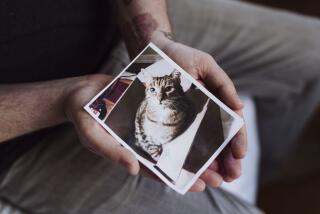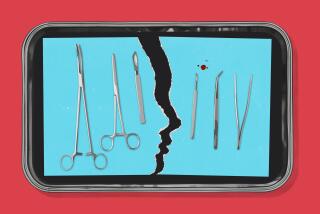Deception Behind Liver-Transplant Switch Proved to Be Fatal
In January 2003, after more than two years on a waiting list for a liver transplant, Saad Al-Harthi was finally considered sick enough to rank near the top.
If a donated organ became available, he would have only a few hours to get to St. Vincent Medical Center in Los Angeles.
But that same month, Dr. Richard R. Lopez Jr., then-director of the hospital’s liver transplant program, told him he faced a long wait and was better off at home in Saudi Arabia, according to Al-Harthi’s son Majed.
That’s where he was Sept. 8, 2003, when the hospital accepted a liver in his name.
Lopez and Dr. Hector Ramos, his assistant director, transplanted the organ into another Saudi national 50 places behind him on the list, St. Vincent officials now acknowledge. The misallocation, reported by The Times last month, is a serious breach of the national code governing placement of donated organs.
Al-Harthi never knew any of this. He died less than a year later from liver cancer that had spread throughout his body. He was 59.
“They killed my father,” Majed Al-Harthi said in a telephone interview from Rome, where he works for a Saudi oil and gas company. “Intentionally or unintentionally, they killed him, and they have to be punished for it.”
For months leading up to the inappropriate transplant, and for months afterward, the hospital misled Al-Harthi, his family and the Saudi Embassy in Washington about his prospects for a liver, according to letters and e-mails from hospital staff that were reviewed by The Times.
Although the motive behind the transplant switch remains a mystery, the tactic was clear: use one patient’s position on the list to obtain an organ for somebody else. In doing so, the hospital bypassed not only Al-Harthi but dozens of other patients in Southern California whose conditions were deemed more dire than the recipient’s.
Eventually the hospital lost track of Al-Harthi, a popular school principal in his hometown of Taif. St. Vincent administrators learned of his death from Times reporters this week.
Hospital and transplant officials did not identify the transplant candidates in question, referring to them only as patients A and B. The Times has verified the names with three knowledgeable people, including two who have seen the names in hospital documents.
The sources requested anonymity because of patient privacy rules.
Medical leaders at the hospital have hired outside experts to determine if Lopez and Ramos acted improperly. Lopez has resigned from the medical staff, said hospital spokesman Paul Silva. Ramos remains on the staff but has stepped down from the chairmanship of the medical center’s bioethics committee.
The hospital administration is also looking at the conduct of other employees, including two who have said they falsified records as instructed either directly or indirectly by Lopez, according to Silva.
The hospital suspended all liver transplants more than two weeks ago after a routine audit caught the problem, and officials are looking into whether any other organs might have been improperly diverted.
Under national transplant rules, the hospital should have turned down the liver because the intended recipient, Al-Harthi, was unavailable. A patient at UCLA Medical Center was next in line on the list, and doctors there were ready to accept the organ.
In rare instances, physicians can transplant a liver accepted for one patient into another -- but only after consultation with the local organ procurement agency. The hospital is also required to justify such actions to the United Network for Organ Sharing, which administers the national transplant system.
Neither agency was consulted in this case.
For more than a year after the September 2003 transplant, St. Vincent filed documents with the national network showing, falsely, that Al-Harthi had received the liver and was doing well, the hospital has acknowledged.
In fact, the evidence suggests that the surgeons had little intention of transplanting a liver into Al-Harthi.
*
Saad Al-Harthi, a father of five, had a home library of more than 2,000 books and was known around Taif for his charitable demeanor.
He began searching for a liver transplant center in 2000 after his doctors told him he might have cancer.
It wasn’t urgent, but his family was worried because he also had hepatitis C, another potentially lethal disease of the liver.
Foreign nationals are allowed to seek transplants in the United States, and Al-Harthi settled on St. Vincent because several Saudi friends had traveled there for treatment for a variety of ailments. When he visited for the first time that October, the hospital placed him on the regional transplant list and he went home.
The Saudi government agreed to pay his medical bills and travel expenses, as it commonly does for its most seriously ill citizens. Majed, who speaks English, routinely served as a long-distance translator between his father and the medical staff at the hospital.
In January 2003, on Al-Harthi’s fourth visit to St. Vincent, he was told that his condition was stable and that he was still an excellent candidate for a transplant.
“It is crucial that Mr. Al-Harthi return to the United States at least once a year to update his evaluation and status on the waiting list,” Lopez wrote to the Saudi Embassy in a letter dated Jan. 13, 2003.
But Al-Harthi’s score on the standardized medical assessment used to rank liver transplant candidates showed the situation to be more urgent than Lopez suggested.
By the end of that month, Al-Harthi’s score, 30, had put him in strong contention for a liver, said Tom Mone, chief executive of OneLegacy, the regional organ procurement agency.
A score of 30 or higher typically ensures an imminent transplant, said Dr. Ronald Busuttil, the head liver transplant surgeon at UCLA. He said he would tell such a patient that “you need to come and live right next to the hospital.”
Back in Saudi Arabia, Al-Harthi was nervous about his health. He prayed for a liver, and his suitcase was always packed.
All summer, his name crept up the list, as patients ahead of him got livers or died.
His turn came Sept. 8.
OneLegacy called the St. Vincent transplant coordinator to say a donated liver had become available for Al-Harthi, Mone said. The fact that the patient was in Saudi Arabia didn’t stop the hospital from accepting the organ.
There was someone else in the hospital who could use it.
Abdullah Al-Bugami, 42, also happened to be a Saudi national -- and was, according to the Saudi Embassy, a poor man. Suffering from hepatitis B and liver failure, he had been on the regional waiting list since February 2002, according to the embassy. But he was still not sick enough to qualify for a top spot, hospital officials said.
Despite the ranking, Al-Bugami had been in the hospital for a month.
“He was very sick ... swelling all over,” said Debbie Wahler, a nurse practitioner who worked in the liver transplant program at the time. “He was in a lot of abdominal pain.”
Lopez headed to an Inland Empire hospital to remove the liver from a brain-dead donor, Mone said.
At 9:46 a.m., Lopez placed a clamp on the aorta, cutting blood flow to the organs, Mone said. Thirty-two minutes later, the surgeon removed the liver, put it on ice and returned to St. Vincent. Al-Bugami was waiting.
Ramos led the transplant.
His lawyer, Evelina Serafini, said Ramos knew the organ had been intended for Al-Harthi but assumed that staff had received permission from organ procurement officials for it to be reallocated. Ramos always left the paperwork to the administrative staff, Serafini said.
Lopez referred calls to his attorney, David Fisher, who declined to comment.
Al-Bugami’s surgery was completed by 5 p.m., said Mone -- about seven hours after the liver was removed from the donor.
It was a quick turnaround for a donated liver. They can remain viable for transplant up to 12 hours, depending on the quality of the organ.
“We would have had time to make other calls and transport the organ to another facility,” Mone said.
*
The coverup began the next day.
A clerk logged on to the national organ registry and accurately reported that Al-Bugami had received the liver, hospital officials said.
But about three hours later, the officials said, the clerk signed on again to say that he had erred and that it was Al-Harthi who had received the organ.
The clerk later told hospital officials that a nurse had asked him to falsify the electronic record at the request of Lopez, St. Vincent President Gus Valdespino has said.
Al-Harthi was scratched from the list but left to believe that his turn would still come.
Lopez wrote to the Saudi Embassy to arrange Al-Harthi’s next visit. The doctor was not in a hurry.
“This reassessment is not urgent and could take place any time over the next 3-4 months,” he wrote Jan. 12, 2004. “This will be necessary to determine if his liver disease has progressed significantly and to estimate the timing of his transplant operation.”
Al-Harthi’s prayers were growing more desperate.
He was losing weight, and his Saudi doctor had detected dark spots on his liver, according to his son.
When Al-Harthi finally came to the United States in mid-April 2004, Lopez gave him the bad news: Cancer had spread throughout his body, disqualifying him from the list. Lopez told Al-Harthi that his best option was to “go back and spend the rest of his days with his family,” the son said.
At his funeral four months later, 2,000 people showed up, he said.
“My family still feels like he died a month ago,” he said.
As for Al-Bugami, who received the liver, he is doing well, according to a spokesman at the Saudi Embassy.
The Saudi government, which paid for the transplant, is contemplating whether it should send any more of its citizens to St. Vincent, the spokesman said.
charles.ornstein@latimes.com
alan.zarembo@latimes.comMore to Read
Start your day right
Sign up for Essential California for news, features and recommendations from the L.A. Times and beyond in your inbox six days a week.
You may occasionally receive promotional content from the Los Angeles Times.







